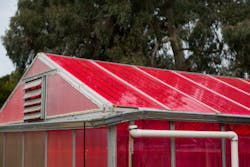Luminescent solar concentrators atop greenhouses harvest power, don't hurt plant growth
Brightly colored research greenhouses at the University of California, Santa Cruz not only house vigorously growing vegetables, but are also equipped with electricity-producing luminescent solar concentrators (LSCs) that take light only from the spectral regions that are less needed by the vegetables. The first crops of tomatoes and cucumbers grown in the greenhouses were as healthy as those raised in conventional greenhouses.
Usually shaped like a pane of glass, a LSC is mostly transparent, but contains luminescent dye that absorbs light within a certain spectral range, then re-emits light at a different wavelength. This light is totally internally reflected within the plate, traveling laterally until it is absorbed by photovoltaic cells and converted to electrical power. These luminescent panels can concentrate sunlight even on perfectly cloudy days, a feat impossible for ordinary concentrating optics.
The LSCs on the UC Santa Cruz greenhouses, which have a magenta appearance, pass the red and some of the green and blue spectral regions through to the plants inside, while piping the rest of the blue and green light to silicon photovoltaic cells. Red and blue light are especially important for plant growth (for example, LED-equipped greenhouses often use red and blue LEDs), as shown by the fact that the vegetables grown in the UC Santa Cruz greenhouses were very healthy.
Narrow strips of photovoltaics
Unlike most LSCs, which have their photovoltaic cells placed on the narrow perpendicular edges of the panels, the UC Santa Cruz version, named the wavelength-selective photovoltaic system (WSPV) by the researchers, contains photovoltaic cells in narrow strips placed periodically on the plate (and able to receive totally internally reflected light), with the WSPV panels composed of 12% silicon photovoltaics and 88% LSC.
The LSC material absorbs about 40% of the 400-700 nm photosynthetically active radiation (PAR) region useful to tomatoes, or about 20% of the solar spectrum useful to silicon photovoltaics. The LSC window version with the most highly optimized geometry and cell type in the lab had a photovoltaic conversion efficiency of 5%, with an efficiency of more like 4% in the field (see figure).
"We have demonstrated that 'smart greenhouses' can capture solar energy for electricity without reducing plant growth, which is pretty exciting," says Michael Loik, professor of environmental studies at UC Santa Cruz and one of the researchers.
To test whether the altered light quality and quantity under the WSPVs would affect photosynthesis for plants, Loik's team monitored photosynthesis and fruit production across 20 varieties of tomatoes, cucumbers, lemons, limes, peppers, strawberries, and basil grown in magenta glasshouses at two locations on campus and one in Watsonville, CA.
"Eighty percent of the plants weren't affected, while 20% actually grew better under the magenta windows," Loik says.
For example, in an experiment where fruit mass and number of tomatoes per plant were monitored over several weeks of growth under the LSC, the researchers found that most tomato cultivars showed no differences between dyed and clear windows, although one had slightly fewer and smaller fruit. However, two other species had similar or slightly higher values for fruit number and mass. The researchers note that characterizing variations in the effect of growth under WSPVs on number, size, quality, appearance, taste, and nutrition for commercially valuable crops should be a high priority for future research.
In additional experiments, small water savings were associated with tomato photosynthesis inside the magenta greenhouses. "Plants required 5% less water to grow the same amount as in more conventional glasshouses," Loik notes.
The WSPV technology was developed by Sue Carter and Glenn Alers, both professors of physics at UC Santa Cruz, who founded a company called Soliculture in 2012 to bring the technology to market. It should be noted that LSCs in general (in other words, not spectrally tailored for use in greenhouses) have been a focus of research by many scientists elsewhere (some of these concentrators are even colorless).
The cost per panel of WSPV technology is 65 cents per watt, about 40% less than the per-watt cost of traditional silicon-based photovoltaic cells. The researchers say that, in addition to use on greenhouses, WSPVs could be deployed for use in solar-power farms over large areas of land that contain plants sensitive to the reductions in light caused by conventional opaque photovoltaic panels, such as croplands and grasslands.
REFERENCE
1. M. E. Loik et al., Earth's Future (2017); doi:10.1002/2016ef000531.

John Wallace | Senior Technical Editor (1998-2022)
John Wallace was with Laser Focus World for nearly 25 years, retiring in late June 2022. He obtained a bachelor's degree in mechanical engineering and physics at Rutgers University and a master's in optical engineering at the University of Rochester. Before becoming an editor, John worked as an engineer at RCA, Exxon, Eastman Kodak, and GCA Corporation.
